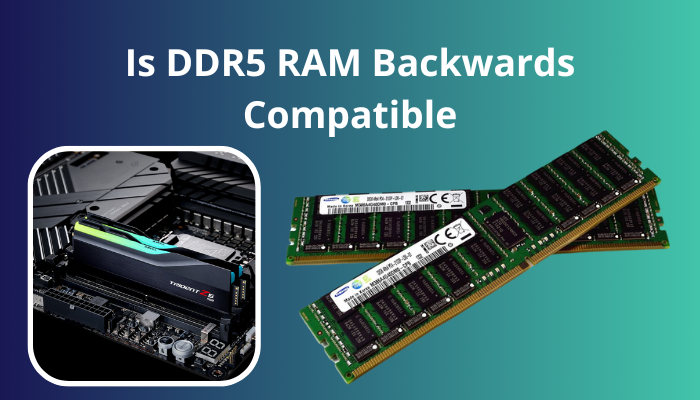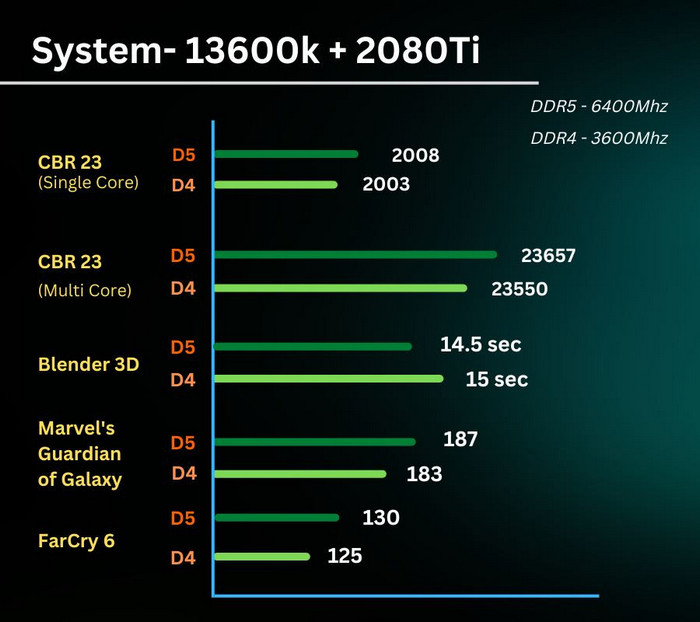The latest generation of memory technology right now is DDR5 bringing astonishing improvements over the previous iteration.
It’s enough to make you want to go out, purchase one and slap it on your PC.
Before you make a big mistake like that, you need to check whether your laptop or desktop is compatible with DDR5. That’s what this guide is all about.
I prepared this after personally attempting to install DDR4 on DDR5 ram slots so grab some caffeine and head to the next section.
Is DDR5 RAM Backwards Compatible?
Unfortunately, DDR5 RAM is not backward compatible. Though DDR4 and DDR5 memories share the same number of data pins, the notch is in a different position. So the DDR5 modules won’t install on a DDR4 motherboard. On top of that, both RAM types share completely different approaches under the hood.
Moreover, DDR5 improves on the existing DDR4 technology significantly in some cases, such as the frequency.
A standard DDR4 memory is typically clocked at 1600mhz to 3600mhz. Based on that, factory overclocked memory ranges from 4000-5000mhz. But 3200mhz kits are the most popular option due to it’s their excellent value
On the flip side, DDR5 memories start from 3200mhz and all the way up to 6400mhz. Further overclocking may achieve over 8400mhz in the future.
Apart from this, all the previous generations of memory technology were also backwards incompatible. A DDR4 RAM stick would not fit in DDR3 slot and vice versa. The same goes for every single RAM generation.
Speaking of RAMs, did you notice whether all of your RAM is being used by your PC or not? If only half is being used, I highly recommend reading this article that explains why only half of your RAM is usable and what to do next.
Why Is DDR5 RAM Not Backwards Compatible?
DDR5 RAM is not backward compatible because of technological and development differences. DDR5 memory is a complete overhaul in contrast to DDR4 sticks. In fact, their physical dimension and DIMM slots are different as well. Intel mentions this issue as the reason for no backwards support.
The technical aspects may sound intimidating I have gathered all the differences between DDR5 and DDR5 RAM to keep things easy and streamlined.
Here are the major differences why DDR5 RAM is not backward compatible:
| RAM Technology | DDR5 | DDR4 |
|---|---|---|
| Bandwidth | 6.4 Gbps per pin at max, but initially, it stays at 4.8Gbps. | 3.2Gbps per pin. |
| Frequency | Starts at 3200mhz and goes up to 6800mhz. The frequency will go over 8400mhz when more and more companies come up with their overclocked versions. | Anywhere between 1600-3600mhz. Factory OC models can go up to 5000mhz. |
| Power Management | There’s a dedicated IC on the RAM itself. Also known as Power Management Integrated Circuit (PMIC). As a result, these kits are more power efficient. | Gets power from the motherboard. So the efficiency depends on the board. |
| Channel Architecture | 2 channels for each memory stick. Each of the channels has a 2x40 Bit Bus. 32 is used for Data and 8 for error-correcting. | 1 channel for each memory stick. And it’s made up of 72 Bit Bus. Where 64-bit for Data and 8-bit for error-correcting. |
| Burst Length | 8 | 16 |
| Maximum Memory Capacity | 64Gb per Die. RAM manufacturers put multiple Die on each side of the stick. Typically 8 of them on each side. Maximum memory capacity on DDR5 RAM = 64Gb per Die * 16(8 on each side *2) = 1024 = 128GB However, there are no 128GB single memory stick available at the moment. But the headroom is there. | 16Gb per Die. The maximum memory capacity on DDR4 = 16Gb per Die * 16 = 256Gbit = 32GB This is why you will only find a maximum of 32GB memory on a single DDR4 RAM. |
| Price | Higher | Lower |
So, this is a comparative look at how the two technologies differ from one another. When you consider the number of differences they both have, it should make sense that they won’t be compatible with one another.
Interested in seeing a more detailed comparison between DDR4 and DDR5 RAM? Read this epic comparison post on DDR4 vs DDR5.
Is It Worth Upgrading To DDR5 RAM?
At the current price, it is not worth upgrading to DDR5 as a mainstream consumer. Steep prices of DDR5 motherboard and RAM do not scale linearly in your computer’s gaming and productivity performance. You only need DDR5 if performance is a high priority for you.
DDR4 is currently considered to be the most valuable memory right now
To simplify, allow me to analyze the current PC market.
Let’s say you want to build a system for gaming and a bit of streaming, or you want to build one for your work and you don’t want to rob the bank.
Considering the circumstances, the Intel Core i5 13600K is a brilliant choice at the time of writing this article. The $330 price tag is worth it for its performance and efficiency.
Moving on, we need a motherboard that supports DDR5 RAM. You can choose a decent board with all the basic features like the MSI PRO B660 WiFi DDR5 board which costs $160.
To achieve the best value, I suggest picking the fairly cheap yet great quality 2x Kingston Fury Beast 8GB 5600mhz kits for system memory. So, the total system memory is now 16GB. These components can set you back $140.
Total DDR5 Platform Cost = $330 (CPU) + $160 (Motherboard) + $140 (RAM) = $630
Let’s calculate the total cost of the DDR4 platform, keeping the same CPU. The motherboard and RAM I used are AsRock B660 Phantom Gaming DDR5 ($130) and Corsair Vengeance 8*2 3200Mhz RAM ($70).
Total DDR4 Platform Cost = $330 (CPU) + $130 (Motherboard) + $70 (RAM) =$530
DDR5 platform costs 18% over the DDR4. And that’s with an entry-level motherboard and RAM. This graph will only grow exponentially depending on your motherboard and memory selection.
But the question is, does that 18% extra money provide 18% more performance? Absolutely not!

As you can see from my benchmark, the performance difference across multiple games and applications, such as Cinebench R23, Blender, Farcry 6 etc., is 5% in best-case scenarios. This is imperceivable in real life. You are well off with a 3200mhz or 3600mhz DDR4 kit.
However, if you want the best-performing rig and money is no constraint, go for an expensive motherboard and DDR5 memory.
Before upgrading, you need to know what type of RAM you have installed. Take a look at this 2-minute article on how to tell what kind of RAM you have, before moving forward.
How much faster is DDR5 than DDR4?
DDR5 memory speed is more than 40 percent faster than DDR4 when it comes to data transfer rates. However, it’s important to keep in mind that performance cannot be measured simply using numbers. While DDR5 has faster bandwidth, it falls behind in latency.
DDR (Double Data Rate) is a generation of RAM that has been used in computers since DDR2. Compared to DDR4, DDR5 RAM may use up to twice the pin layout, making it faster and more efficient than DDR4.
With the new Alder Lake processors, users can now use DDR5 memory modules on the same motherboard as their DDR4 modules.
However, it’s important to note that it’s not possible to fit a DDR5 RAM module into a DDR3 slot as they have different designs. Furthermore, due to the design of the RAM itself, DDR5 memory is much faster than its predecessor, DDR4.
This means that users can achieve higher levels of performance with the same amount of memory on their motherboard compared to when using a DDR4 module.
In conclusion, if you’re looking for higher levels of performance from your computer, then you should definitely consider upgrading to a newer generation such as DDR5 type of memory.
Does AMD support DDR5?
At the moment AMD does not support DDR5 memory standard. However, with their Ryzen processors, AMD supports up to DDR4 RAM sticks. These RAM sticks require a lower voltage than Intel’s DDR3 and have increased power efficiency. AMD only supports DDR5 on the AM5 platform as of now.
This allows more data to be transferred at a faster clock speed while consuming less power. Additionally, higher RAM capacity and improved memory controller technology found on the Ryzen processor make it possible to reach faster speeds with lower latency times compared to Intel’s processors.
Although AMD does not yet support DDR5, they are working on developing this technology which may soon become available on the market.
In conclusion, while AMD currently doesn’t support DDR5, their Ryzen processors give users access to high-performance RAM at lower power consumption levels than other solutions currently available on the market.
FAQs
Can DDR4 RAM Fit in a DDR5 Motherboard?
No, DDR4 RAM can not fit in a DDR5 motherboard. The notch on the DDR4 memory is not in the same position as the DIMM slot on the DDR5 motherboard.
What Are the DDR5 Compatible CPU?
Ryzen 7000, Intel 12th, and 13th generation CPUs are DDR5 compatible. On a bright note, Intel supports DDR4 memories too.
Can I mix DDR4 and DDR5 RAM?
No, you cannot mix DDR4 and DDR5 RAM. They are completely different.
Are DDR5 Motherboards Backward Compatible?
No, DDR5 motherboards are not backward compatible. The cutout for installing the RAM on the DIMM slot does not match any previous generation RAM technology such as DDR4, DDR3 etc.
Final Remarks
DDR5 is the future but not a valid idea to install on your current system and call it a day. The dissimilarities with the existing DDR4 technology require you to buy new compatible components to make it work.
For more breathtaking insights, comment down below.



